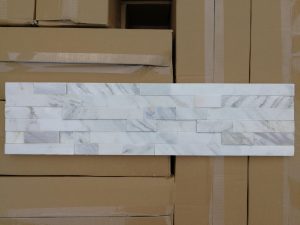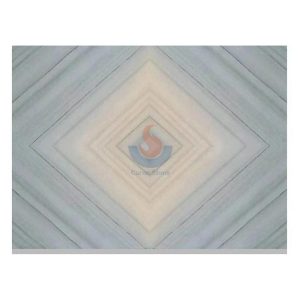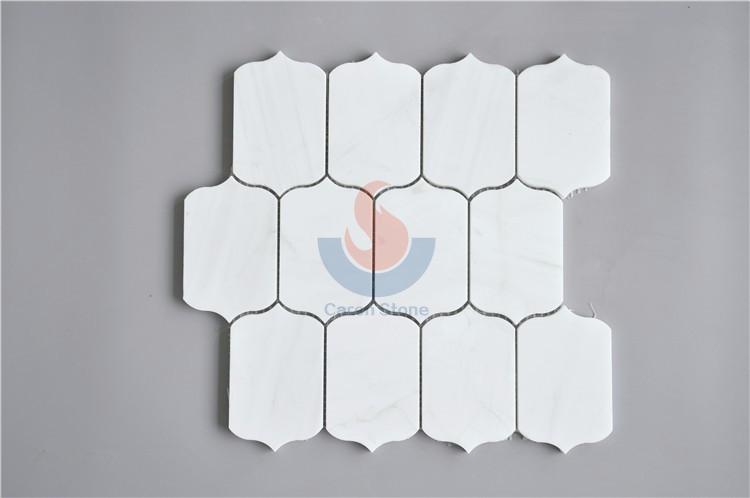Among the many marbles, white marble is undoubtedly one of the most widely used stones. White marble is used in high-end and luxurious walls, floors, background walls, stairs, countertops and other places. Some people even use white marble in various ways, such as clothes, light bulbs, fruit plates, loudspeakers, and even toilets.

Volakas Marble ,Greece white marble ,White marble split and Grooved face ledger stone panel, culture stone ,wall cladding ,stone veneer panel , stone wall decoration
The simple elegance, noble temperament, softness and delicacy of white marble are really addictive, and the decorative effect is even better than that, which is simply amazing. Its gentle tones, snow-white, and pure beauty like snowflakes allow many designers to fully utilize and display it.
But it is also the most loved and feared variety, but the hypocritical, fragile and difficult to serve white marble in terms of anti-fouling make some users regret it, especially the fact that white marble is easy to yellow makes many users who love white marble stay away.
If we want to solve the quality problems such as yellowing of white marble, then we have to analyze the internal and external factors, thoroughly understand the nature of marble, and the root cause of quality problems, so as to solve the fundamental problems. So what causes white marble to turn yellow? How can white marble maintain its original appearance? Here are some tips!
The structure and composition of white marble
A study of the most common white marble surface using a scanning electron microscope found that on the surface and lines of white marble, there are iron minerals with particle sizes ranging from 2 microns to several hundred microns, some of which are distributed on the surface of the board, and some are enriched in the lines.
The oxidation of iron minerals contained in white marble is considered to be the main cause of the yellowing of marble. Since most marbles have a relatively single and uniform color except for the lines, when the iron-containing minerals randomly dispersed in the marble are oxidized to form yellow or brown hydrated iron oxides, flaws on the board surface and aesthetic stains are formed, which is particularly prominent for white marble.
The iron in white marble mainly exists in the form of ferrous sulfide, iron carbonate and magnesium iron silicate, which are dispersed in the marble matrix or enriched in the lines of the marble.
When these divalent iron minerals on the surface of the stone are oxidized to trivalent iron by oxygen in the air and combined with water to form hydrated iron hydroxide, rust is formed, commonly known as yellowing. If no protective measures are taken, this yellowing phenomenon will appear 8-12 months after the marble is placed.
An interesting phenomenon is that the yellowing phenomenon does not occur when the marble is placed next to a heat source, such as a hot water pipe, which shows that the yellowing phenomenon of white marble is closely related to water. However, contact with water does not necessarily cause the yellowing phenomenon of white marble.
The thermal shock test on white marble shows that the stone sample is placed in 15-25℃ deionized water for 6 hours, and then the sample is placed in an oven at 100-110℃ for 18 hours. After 20 such cycles, it was found that only the sample with rich iron on the surface showed a slight yellowing phenomenon, and the degree of yellowing was much lower than the natural yellowing phenomenon.
This experimental phenomenon shows that due to the very low conductivity of deionized water, the redox reaction of divalent iron being oxidized to trivalent iron proceeds very slowly. Therefore, although the sample has been immersed in water for a long time and has been cycled for many times, there is no obvious yellowing phenomenon.
This test result shows that the yellowing phenomenon of white marble is the result of oxidation and hydration acting on the divalent iron minerals on the surface of the stone, and these two conditions are indispensable. Unlike soaking in ion water, white marble is very easy to cause yellowing when immersed in alkaline solution.
The same stone sample was placed in 15-25℃ alkaline water for 6 hours, and then the sample was baked in an oven at 50-60℃ for 18 hours. After 20 such cycles, the test found that all the white marbles selected for the experiment turned yellow, and Carrara white marble was the most serious.
Alkaline solution easily turns white marble yellow because in alkaline medium, the redox potential of divalent iron is reduced when it is oxidized to trivalent iron, and it is easily oxidized to trivalent iron by oxygen in the air. The trivalent iron combines with water to form yellow pollution on the board surface.
The divalent iron on the surface of the stone is oxidized to trivalent iron by oxygen in the air and combined with water to form hydrated iron hydroxide, which has extremely low solubility. Therefore, the yellowing pollution of the board surface caused by iron is not easy to remove. The second type of yellowing pollution of the white marble board surface comes from the organic matter inside the marble. These organic substances exist in the formation process of marble, and their structure is similar to that of humus.
These water-soluble organic substances in the marble often show brown-yellow color when reacting with alkaline water. Due to the existence of such organic matter inside the marble, when the marble floor or wall panel without waterproof treatment on the back of the board is wet-installed, the alkaline water of the cement slurry penetrates the marble and reacts with the organic matter in the marble to generate colored products. When these colored products are brought to the surface of the stone by water, the second type of pollution on the stone surface is formed.
Even during the use period after the stone is installed, due to climatic reasons, whenever water penetrates the cement concrete and then seeps out of the stone surface, it will always bring out colored organic pollutants to the stone surface.
External reasons
The above two types of pollution of white marble come from the composition and structure inside the stone, and occur under the influence of external conditions. In addition to these two types of pollution related to stone components and structures, there are several other external pollution sources:
1. Yellowing caused by wear
As the marble polishing surface wears, dirt is brought into the pores on the marble surface as you walk, and these dirt makes the white marble surface appear yellow.
2. Yellowing caused by improper care
The most common improper care is to wet mop the floor with a dirty mop. The dirt brought by the dirty mop accumulates in the marble, causing the marble surface to be contaminated and turn yellow.
3. Yellowing caused by waxing
When wax is commonly used to polish the marble surface, the thick wax layer turns yellow due to its own aging.
4. Yellowing caused by crystal surface treatment
The steel wool used in crystal surface treatment, with tiny fine powder remaining in the micropores of the polished marble slab, becomes the source of yellowing, especially when the marble is crystal surface treated in a wet state, yellowing is more likely to occur.
5. Yellowing caused by the installation process
Yellowing caused by installation is easily overlooked, but it is common.
Before installing marble floors or walls, the stone standard board is treated with the so-called six-sided waterproofing: the bottom surface is waterproof and adhesive, and the four sides and the front are treated with a penetrating waterproofing agent.
If such six-sided waterproofing is done very well, the quality of the selected waterproofing materials is also guaranteed, and theoretically, the yellowing phenomenon related to water should not occur again. But the fact is that even if the six-sided waterproofing of the stone board surface is considered to be done well before installation, the yellowing phenomenon of the board surface still occurs from time to time after installation.
6. Yellowing of stone related to installation
It is mainly caused by two aspects. One is that due to the need for installation size, on-site cutting destroys the original waterproofing treatment on one side; another possible situation is that the construction environment is dirty and the cement slurry falls on the board surface during the construction process. In order to prevent the fallen cement slurry from drying up on the board surface, the fallen cement slurry is wiped with a wet towel. At this time, it is very likely that the strongly alkaline cement water will be smeared into some dark cracks on the board surface, because even if the board surface has been treated with penetrating waterproofing, the tiny waterproofing agent molecules cannot form a protective film across the cracks at the cracks to shield and protect the cracks.

Popular White Marble, Columbia white marble Slab Flooring with Good Price
Therefore, the coverage of waterproofing agent in the cracks is very limited. When installing, scraping the sides of the standard board with cement slurry back and forth with a putty knife will also destroy the waterproof treatment that has been done. If cement water is accidentally brought into the cracks of the board surface when wiping the board surface, the yellowing of the board surface is a matter of sooner or later, not whether it will turn yellow.





